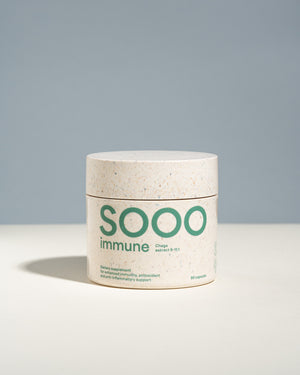Chaga - our immunity's best friend
Sooo, are you ready to unlock the potential of Chaga and embark on a voyage toward radiant well-being? Let us embrace the wisdom of nature's bounty and illuminate the path to vitality and radiance together. Here's to a harmonious fusion of health and beauty!
Wonderful Anti-aging Properties of Chaga
Let's delve into a groundbreaking study involving Alaskan Chaga (I. obliquus), a revered component of natural remedies.
Through the creation of a Chaga tea-like extract administered to the microscopic Caenorhabditis elegans, researchers unveiled a remarkable discovery. These tiny worms exhibited an astonishing 22% increase in lifespan with select doses of Chaga [1].
Furthermore, Chaga's influence extended beyond longevity; it imbued the aging worms with vitality and vigor. This rejuvenating effect was particularly notable in high doses, where fewer worms succumbed to sedentary behavior.
Notably, Chaga exhibited a calming influence on stress markers within these organisms, fostering a state of serenity.
The bottom line? Chaga emerges as a fountain of youth, breathing vitality and tranquility into the aging process.
Ally of Immunity in the Battle Against Tumors
Chaga emerges as a superhero in the battle against tumors, revolutionizing conventional treatments.
Bursting with potent compounds, Chaga not only bolsters the immune system by amplifying infection-fighting cells but also orchestrates a farewell to tumor cells while safeguarding healthy tissues.
Armed with a formidable arsenal, including inotodiol [2] and lanosta-8, 23E-diene-3β,22R,25-triol [3], Chaga stands as a stalwart defender against tumor proliferation and dissemination.
Its efficacy spans centuries, with historical accounts of Chaga's utilization dating back to the 16th century. Combined with modern ways of extraction, Chaga is a steadfast ally in the ongoing battle against malignancy today.
Antiviral Adversary
Beyond its evocative name, Chaga emerges as a formidable adversary against viral pathogens. Its constituents exhibit a remarkable capacity to impede the progress of viruses, for instance, halting the advance of HIV-1 [4] protease.
Betulinic acid, mycosterols, hispolon, and hispidin are among the heroic compounds found within Chaga's repertoire, acting as vigilant sentinels against viral invasion [5].
While the precise mechanisms remain under scrutiny, scientists remain vigilant in uncovering Chaga's secrets, holding the promise of pioneering new antiviral therapeutics.
Antimutagenic Guardian
Chaga emerges as a guardian against genetic anomalies, wielding compounds such as inotodiol and 3β-hydroxylanosta-8,24-diene-21-al to mitigate the risk of mutations [6].
These compounds act as vigilant sentinels, fortifying DNA against the ravages of mutagens. With the potential to reduce mutation rates by a staggering 80%, Chaga emerges as a natural shield against genetic aberrations, offering hope in the prevention of hereditary disorders [7].
Powerful Natural Antioxidant
Chaga stands as a bastion of defense against oxidative stress, armed with triterpenoids, benzoic acid, and an array of other potent antioxidants [8]. These compounds engage in a relentless battle against free radicals, safeguarding against a myriad of health issues.
Polysaccharides within Chaga's arsenal further reinforce its antioxidant prowess, shielding the body from oxidative damage linked to various ailments.
Anti-inflammatory Defender
As our body's defense mechanisms teeter on the brink of hyperactivity, Chaga emerges as a beacon of tranquility.
Extracts from Chaga exert a calming influence on the production of inflammatory cytokines [9], promoting a harmonious balance within the body.
Additionally, Chaga's anti-inflammatory peptide intervenes to prevent excessive platelet aggregation [10], contributing to the maintenance of homeostasis.
Other Biological Activities
Chaga's versatility extends beyond conventional boundaries, boasting an array of benefits such as diabetes management [11] and immune modulation, offering a holistic approach to well-being.
Key Components
Unravel the mysteries of Chaga's essence, adorned with polysaccharides, betulin, and betulinic acid derivatives.
Recommended Usage
Recommended usage typically ranges from 250 to 500 mg of an 8:1 extract, administered two to three times daily. However, individual dosage may vary based on factors such as age, health status, and extract quality.
Caution
Exercise caution due to high oxalate concentrations and potential mushroom allergies.
[1] Scerbak, C., Vayndorf, E. M., Hernandez, A., McGill, C., & Taylor, B. E. (2016). Mechanosensory Neuron Aging: Differential Trajectories with Lifespan-Extending Alaskan Berry and Fungal Treatments in Caenorhabditis elegans. Frontiers in Aging Neuroscience, 8. https://doi.org/10.3389/fnagi.2016.00173












